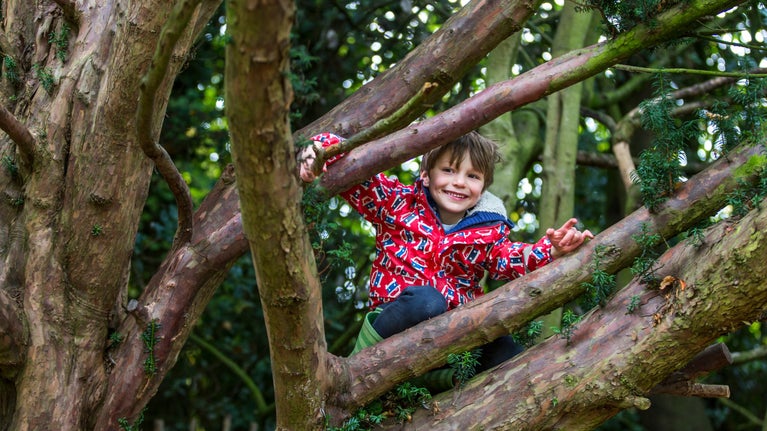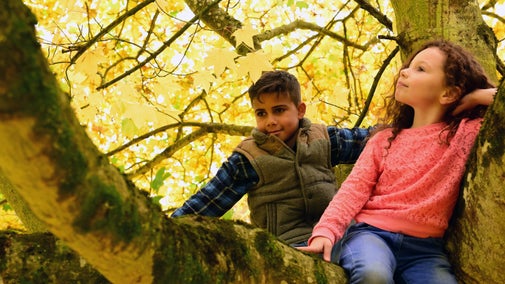
‘50 things to do before you're 11¾’
Have fun exploring nature and the great outdoors with our list of ‘50 things to do before you're 11¾’.

Watching a wriggly caterpillar turn into a magnificent butterfly is fun. Discover our top tips for giving a caterpillar a good home and match pictures of caterpillars up with their butterflies. Find out the best way to release a butterfly once the transformation has taken place.
The first thing you'll need to find is a place for your caterpillar to feel at home. A small tank, netted cage or plastic tub would all work well. It’s great if you can see through the sides, so you don’t miss any of the action.
Use fine netted mesh or a plastic lid with very small, smooth holes to cover your container. This will give your caterpillar lots of fresh air, while making sure it doesn’t escape.
You will also need:
You’ve made the perfect place for your caterpillar. Now you need to find one! Going on a caterpillar hunt is all part of the fun – why not invite your family or friends to join you?
Search your garden or nearby green spaces for caterpillars or eggs. The best places to look are under leaves with fresh bite marks, around vegetable patches, or in hedges.
Caterpillars love to eat nettles, so keep a lookout for these too – but take care not to get stung. It’s always best to check with an adult before you go seeking.
Move the slider to see it transform
Keep hold of the leaves you found your caterpillar on. These are probably its favourite food and will be useful when it comes to dinner time.
Be careful if you discover hairy caterpillars. Some hairy caterpillars can cause a rash and make you feel unwell if you touch them. Although most will cause no harm at all, it’s best to steer clear of them anyway.
Some caterpillars are well-camouflaged and hard to find, while others are brightly coloured and have patterns to scare off predators. What will you discover?
Once you’ve found your perfect caterpillar friend, you’ll need to do a bit of research to find out more about it. What is it going to turn into? How long is its life cycle from caterpillar to butterfly or moth? What does it like to eat?
Look in books, search the internet, or ask an expert if you know one.
Caterpillars love to munch on small cuttings of fresh leaves every day and they might like some bark and pencil-sized twigs to crawl over and hang from.
You’ll also need to clean them out regularly – old leaves and caterpillar poo can go mouldy, which might make your caterpillar sick.
You can bring up your butterfly indoors, but keep its home out of direct sunlight so it doesn't get too hot. Kitchen roll is great for keeping your container dry, clean and free from damp too.
Once your caterpillar has become a pupa or chrysalis, it’s time to step back, watch and wait. Carefully remove any leftover food and spray a tiny bit of water every few days so it doesn't dry out, making sure not to disturb your sleeping beauty.
It can take as little as four weeks for your caterpillar to turn into a butterfly, or as long as a whole year. It depends on the season and the type of caterpillar you have chosen. It will eat lots and then become a pupa or chrysalis, before emerging as a butterfly or moth when it is ready.
You could keep a diary with notes, drawings, photos and even videos of the different stages of your butterfly’s lifecycle. What colours, patterns and textures do you notice in the different stages?
The moment has finally arrived – your fluttery friend has emerged! If you're lucky, you may see it slowly unfurl its wings as it wakes up from its sleep. What does it look like? Was it what you expected?
More than 2,000 species of moth have been found in the UK, so there's a good chance your caterpillar may turn into a moth rather than a butterfly. Either way, your winged pal will now be ready to explore the outdoors, find a mate and begin the cycle all over again.
Watch as your butterfly stretches its wings and flies away. See if you can follow it as it flutters from flower to flower. Where does it choose to land first? Does it look different in the wild?
Before you gently release your butterfly or moth into a safe space in the wild, make sure you take a photo or drawing for your diary, so you always have the memory.

Have fun exploring nature and the great outdoors with our list of ‘50 things to do before you're 11¾’.
Try and get to know a tree - the first of our ‘50 things to do before you’re 11¾’. Search for clues in its roots, bark and branches to uncover its story.

Find out what’s in a pond by scooping out some water and using our guide to identify what's beneath the surface. It's No. 35 of the ‘50 things to do before you’re 11¾’.

Stargazing is a magical way to bring nature to life. We have tips on the constellations to spot and the stories behind them. Going stargazing is one of our list of ‘50 things to do before you’re 11¾’.

As the tide goes out, the secrets of the sea are revealed in rock pools left behind. Exploring the wonders of a rock pool is no. 37 of the ‘50 things to do before you’re 11¾’.
